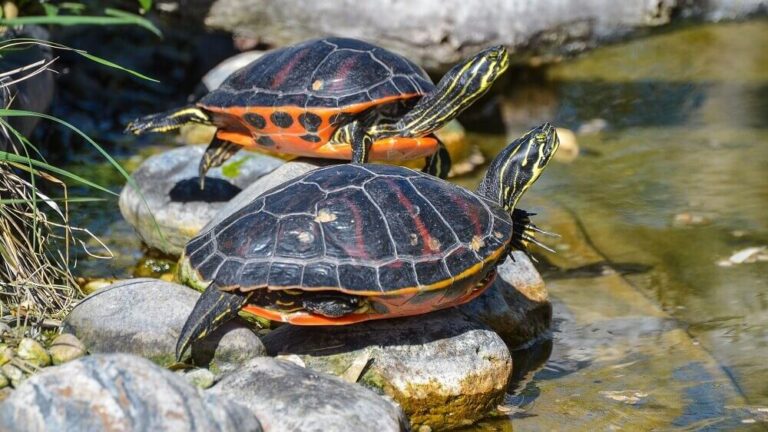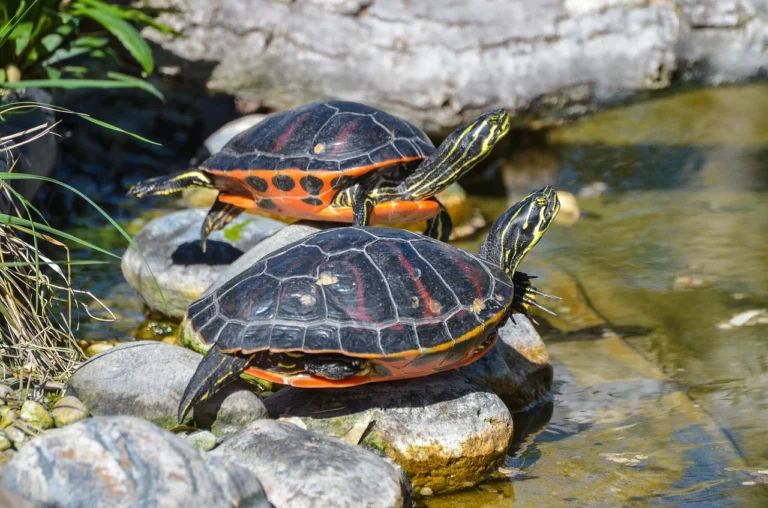Turtles are great pets, provided you provide them with the ideal habitat. Aquatic and semi-aquatic turtles have certain requirements that must be met for them to thrive. Different turtle requires slightly different habitat condition. So, it’s best to get as much info about the specific turtle from the pet store while getting it.
Generally, a healthy turtle habitat includes a variety of necessities such as a heat lamp, water, and plants, amongst other things. This guide will walk you through some essential things to have in your turtle tank. We’d also recommend some of the best plants for turtle tank you can consider.

How to Create a Healthy Turtle Habitat
It’s easy to create a healthy habitat for your turtle tank. Unlike some aquatic pets, turtles are one of the easiest to care for. Provided their environment is conducive to sufficient food sources, turtles can live their whole lifespan in health. Some general things to consider for building the ideal turtle tank include the following:
Sufficient Space
The first thing you want to consider is the size of the turtle tank. Unlike fish, turtles require plenty of room. The idea is to ensure the turtle has sufficient space to move around comfortably. Confining turtles to a small space makes them timid and reduces their life expectancy.
Lighting
Another thing to consider is that turtles require adequate lighting. Ultraviolet A and Ultraviolet B are best for turtles. When installing these lights, place them at least 12 inches from the turtle. And to prevent overexposure to lighting, use a timer to simulate the day and night cycle.
A turtle needs between 12 to 14 hours of light and about 10 to 12 hours of darkness. Ideally, it would help if you switched out the UV lamps every six months to a year. But if you can, place your turtle tank where it can get direct sunlight for the best result.
Water Quality
Also, it’s essential to maintain a healthy and clean environment for your turtle to swim. As such, having a proper filtering system in place is a must. Make sure you have a strong enough filter suitable for your tank size. Not using a filter will mean you must change the water frequently when dirty, which can be a lot of work. However, using a filter makes keeping the water clean seamless.
Heating
Turtles require a decent amount of heat to remain active. Moreover, turtles are ectothermic, meaning they depend on an external heat source to regulate its body. So, if the habitat is too cold, your turtle will get too cold. So, to ensure your turtle is getting sufficient heat, it’s best to install heaters with a thermometer.
Ideally, two thermometers are best to measure the air and water temperature. Research the specific temperature range for your turtle, but on average, you should maintain the temperature between 75°F to 85°F with a 5° to 10°F decrease at night.
Decide on Plants and Basking Surfaces
Plants are a desirable addition to include in the habitat of a turtle tank. It keeps the tank looking like the natural habitat of the turtle. Also, it gives the turtle some security. Additionally, providing a basking surface for the turtle to play keeps them energized and healthy. You can use artificial plants or natural plants.
Some turtles may attempt to eat the plant, so sticking with real plants is best. Also, you can provide the turtles with some rocks and driftwood for the basking surface. Adding substrate to the tank may benefit the plants, but it may also make cleaning the tank a tad bit difficult.
Best Plants for Turtle Tank
Adding the best plants for an aquatic turtle tank provides a hiding spot and makes your turtle feel safe. It also adds to the aesthetic appeal of your tank. And considering some turtles eat the plant, it’s best to consider the aesthetic appeal and choose one that is not poisonous. You can consider adding several plants to your tank, but below are the best for your turtle tank.
Java Fern Aquarium Plant

The java fern is one of the most recommended plants to use in a turtle tank because it is easy to care for and affordable. You can grow this plant in your turtle tank with little to no care. Its many aquarists’ favorite aquarium plant because of its minimal light requirement. Having a bit of substrate in your tank base will help the plant grow better as they are root feeders.
On average, when fully grown, java fern can reach a height of around 5 inches. On a side note, trim the leaves of this plant now and then to encourage new ones and improves its aesthetic appeal.
Water Hyacinth Aquarium Plant

Water hyacinth or Eichhornia crassipes is another aquarium plant you can include in a turtle tank. As a floating aquatic, the water hyacinth produces thick waxy leaves that look attractive. Also, the leaves make an excellent snack for turtles to nimble on when hungry.
The water hyacinth is typically found in tropical regions and is a fast-growing plant that can pull excess nutrients in your aquarium, thus keeping it clean and clear. The best feature of the water hyacinth plant is that it has no special requirements, as it thrives in an environment with moderate to high light and temperatures ranging between 68° and 80° F.
Java Moss Aquarium Plant

Java moss, or Taxiphyllum barbieri, is one of the most versatile tropical freshwater aquarium plants. It requires no specialized care, such as special lighting. The plant’s appearance adds a natural feel to your aquarium, as it can grow on driftwood, rocks, etc.
By draping it on high or low branches, you can efficiently utilize java moss to create an aesthetically appealing aquascape in your turtle tank. And because java moss is a fast-growing plant, your turtles can snack on it, and it will replenish itself.
Water Lettuce Aquarium Plant

Water lettuce, or Pistia stratiotes, is a tropical aquatic plant native to Africa and South America. It is an excellent plant to grow in a turtle tank because it is easy to grow and can serve as a natural water filter. It can help control algae problems that may decrease the tank’s oxygen levels.
This plant also provides excellent shade for your turtles. But be aware that the water lettuce is an invasive plant that propagates rapidly and may crowd other plants if not maintained properly.
Duckweed Aquarium Plant

Duckweed is another popular aquarium plant you can consider. There are several species of duckweed, giving you several options to choose what will best suit your need. It is abundant in Africa, North America, Asia, and Australia.
The Spirodela polyrhiza, or giant duckweed, is a popular option because of the large lush green blanket it forms over the water’s surface. Or you can go for the Lemna minor for its tiny free-floating leaves that are hardy and tolerant.
Another reason to consider the duckweed aquatic plant is that it is a natural filter that removes toxic chemicals from the water and controls the spread of algae.
Conclusion
In summary, creating a healthy turtle habitat cannot be overemphasized enough. A lot goes into creating a healthy habitat for your turtle. Aside from ensuring the tank space is sufficient, light is adequate, and water quality is high, plants are vital for their enrichment.
Adding plants to your turtle tank does not beautify it. So, ensure you properly research and include only the best plant for turtle tanks.






